Homemade Strawberry Vinegar
Creating strawberry vinegar from white wine and strawberry tops is an innovative and sustainable approach to crafting vinegar. It’s zero waste too, using strawberry tops you’d otherwise throw away.
First, you must prepare the white wine by removing the sulfites using hydrogen peroxide. This crucial step ensures that the sulfites do not hinder the microbes that ferment alcohol into acetic acid, allowing the transformation of wine into vinegar.
After you prepare the wine, you can add in the strawberry tops. These tops infuse the vinegar with a subtle strawberry flavor and a hint of sweetness.
Then, you ferment the mixture with a vinegar mother, a symbiotic culture of bacteria and yeast. Over time, the vinegar mother metabolizes the alcohol in the wine, converting it into acetic acid. Acetic acid is the primary component that gives vinegar its distinctive tangy taste.
You’re going to love this beautifully crafted strawberry white wine vinegar. You can use it to flavor salads, marinades, and sauces.
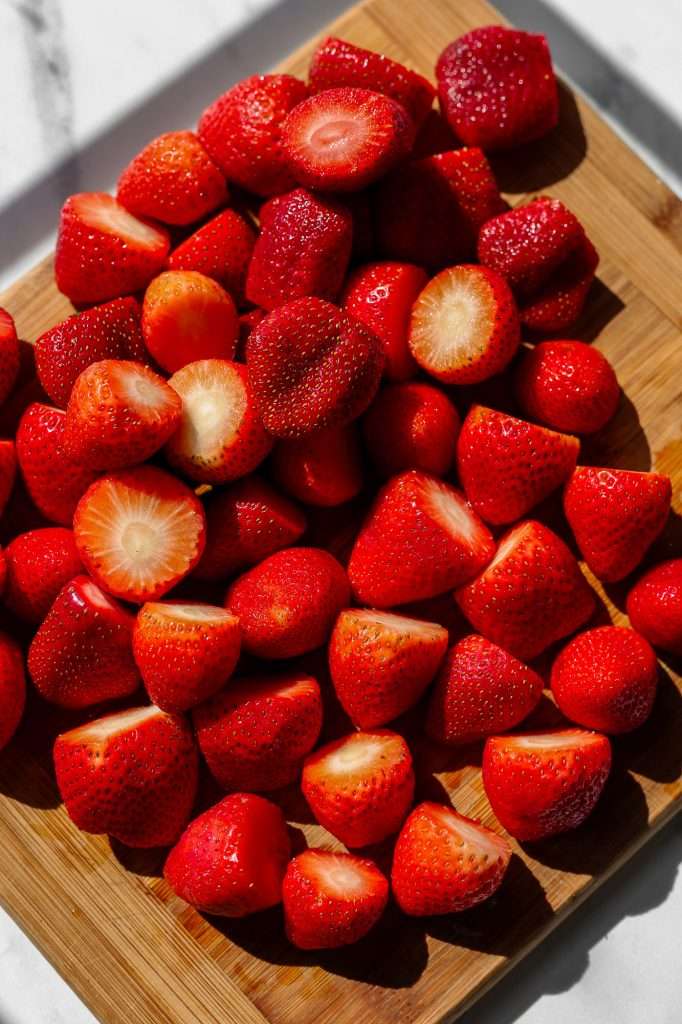
Strawberry Tops Vinegar
Strawberries hold a place of special significance in Louisiana, especially during the spring. Each spring, our state celebrates the peak of its strawberry season.
This vibrant and juicy fruit is not just a popular crop; it’s a cornerstone of local agriculture and community life. Ponchatoula, for instance, is famously dubbed the “Strawberry Capital of the World.”
In spring, Louisiana’s landscape is dotted with strawberry fields, bringing a burst of life and color to the region. The importance of strawberries extends beyond their economic value; they are a cultural symbol, celebrated annually at the Ponchatoula Strawberry Festival, one of the state’s most significant free community events.
This festival highlights the deep-rooted connection between the people of Louisiana and their cherished strawberry harvest. It’s a time when the community comes together to celebrate the fruits of their labor, showcasing the strawberries’ versatility through various dishes, from traditional pies and jams to innovative culinary creations.
Every year, Jon and I buy a ton of strawberries from local farms and freeze them for use all year long. I always cut the tops off before freezing, and It would be a shame to waste all the juicy strawberry flavor in the tops. So in the spring, we always make this vinegar.
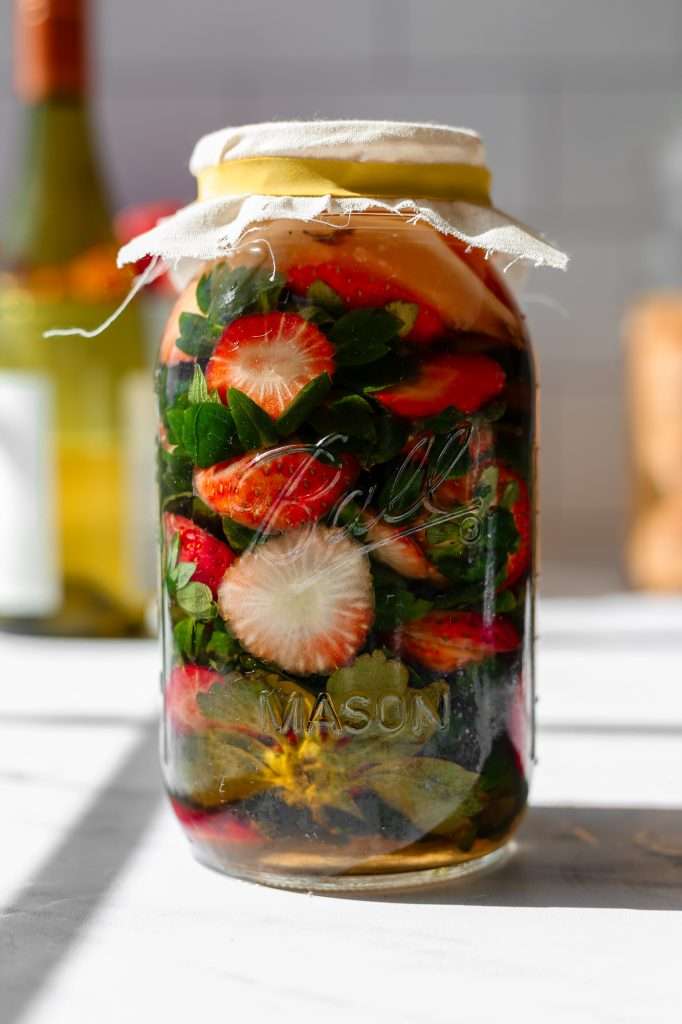
Making Strawberry Vinegar with White Wine
You can use hydrogen peroxide (H2O2) in a chemical reaction to remove sulfites from white wine. Sulfites, which include sulfur dioxide (SO2) and other sulfite compounds, are commonly used in winemaking and other food industries as preservatives to maintain freshness by preventing oxidation and acetic acid bacterial growth. So, you need to remove the sulfites before turning the wine into vinegar is possible.
Removing sulfites using hydrogen peroxide is based on a chemical reaction where hydrogen peroxide acts as an oxidizing agent. When you add a tiny amount of hydrogen peroxide to wine, it reacts with the sulfites present. Here’s a simplified version of the chemical reaction:
H2O2+SO2→H2SO4H2O2+SO2→H2SO4
In this reaction, hydrogen peroxide (H2O2) reacts with sulfur dioxide (SO2), a primary component of sulfites, to produce sulfuric acid (H2SO4) in tiny, harmless quantities. The sulfuric acid is highly diluted in the wine and does not significantly alter the wine’s taste at a proper dilution rate. However, it’s crucial to note that this reaction must be done carefully and in the correct proportions, as excessive hydrogen peroxide isn’t good.
This method is generally not recommended for casual wine drinking, and you should only use it as stated in the recipe.
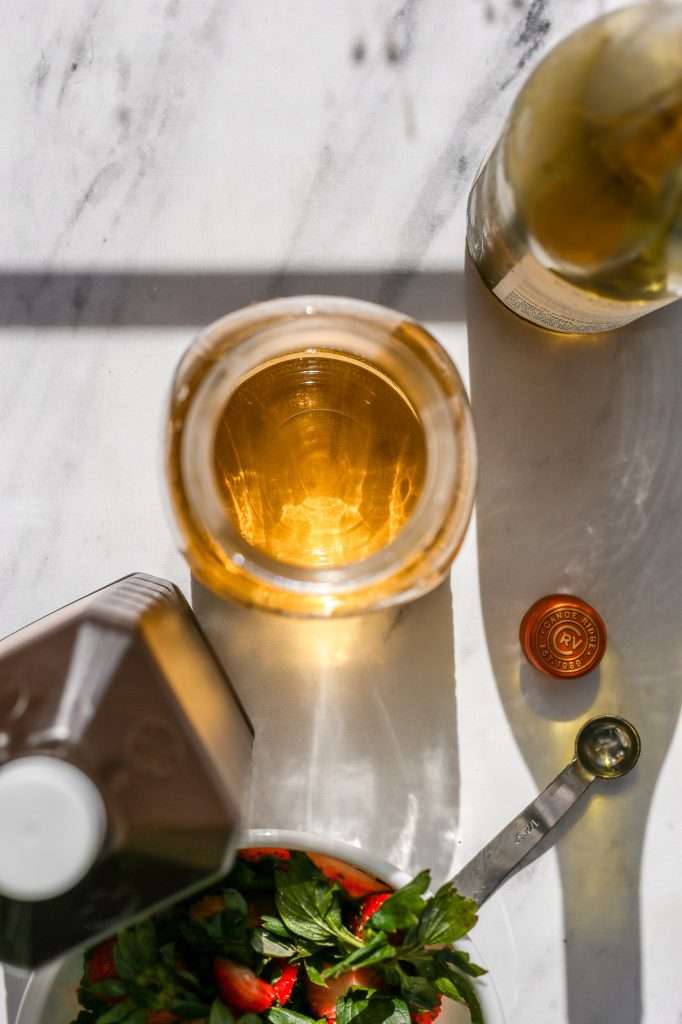
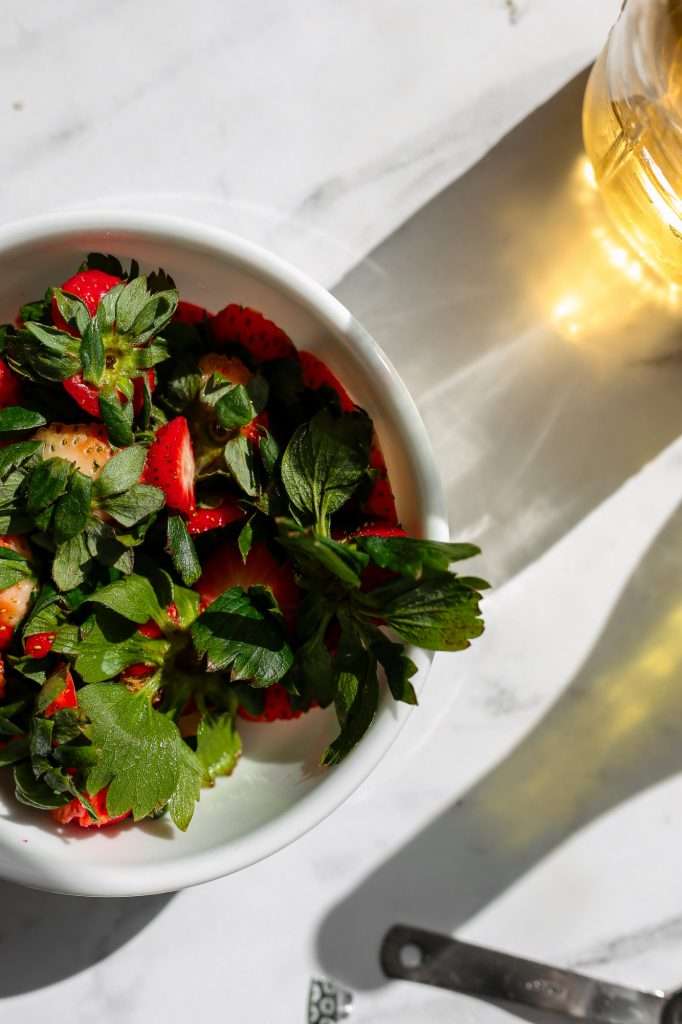
Strawberry Vinegar Ingredients
Here is everything you need to make this recipe:
- 3 cups strawberry tops
- 16 fl ounces white wine
- 1/4 tsp 3% hydrogen peroxide
- 8 fl ounces water
- 3 tablespoons raw apple cider vinegar with the mother
- 32 ounce glass jar
- cloth covering
- rubber band

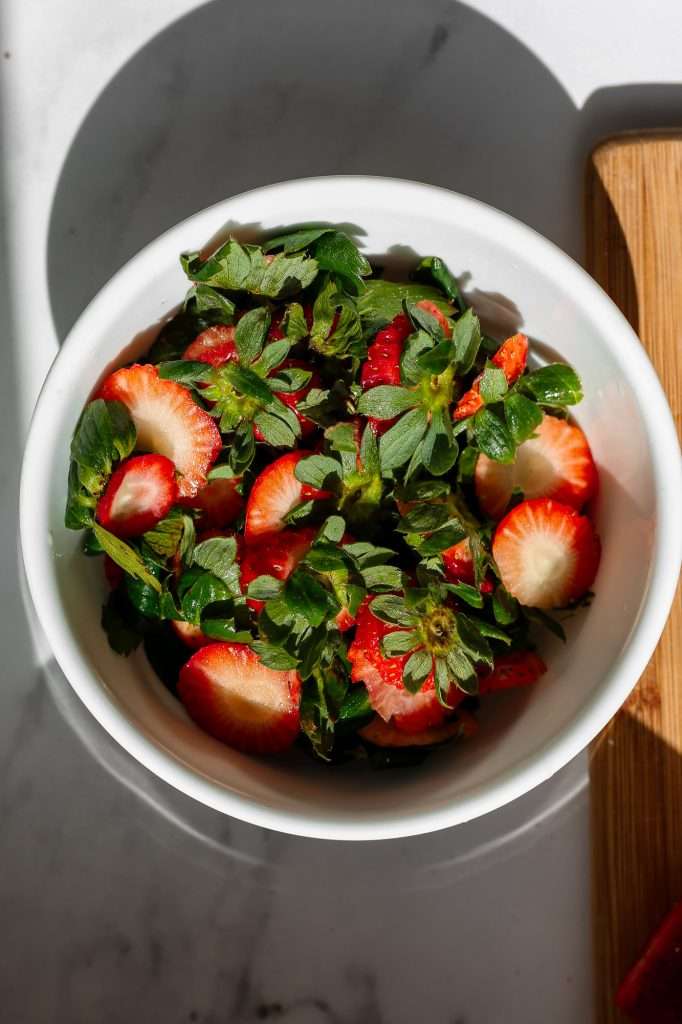
Fermented From Scratch Strawberry Tops Vinegar
There are many recipes online for strawberry top vinegar. However, most of them instruct you to simply add strawberry tops to distilled vinegar. My recipe is fermented from scratch, using wine as the base.
Acetic acid bacteria (AAB) are crucial in the production of vinegar. They transform alcohol into vinegar via a fascinating biochemical process that occurs in two main stages:
Oxidation of Ethanol to Acetaldehyde: The first step involves the bacteria using an alcohol dehydrogenase enzyme to oxidize ethanol into acetaldehyde. This step is crucial as it prepares the alcohol molecule for further oxidation. Fun fact: Acetaldehyde smells like nail polish remover, so if you catch a whiff of that smell during fermentation, know everything is happening correctly.
Oxidation of Acetaldehyde to Acetic Acid: In the second step, another enzyme, acetaldehyde dehydrogenase, oxidizes acetaldehyde into acetic acid. This step completes the alcohol conversion into vinegar’s main component, acetic acid.
This entire process requires oxygen, which is why vinegar fermentation is often referred to as aerobic fermentation, in contrast to the anaerobic fermentation used to produce alcohol.
Acetic acid bacteria thrive at the interface between the air and the fermenting liquid in a nutrient-rich environment provided by alcohol and other organic compounds. This is why a mother “SCOBY” will usually form on the surface of the vinegar.
The efficiency of this process depends on several factors, including the type of acetic acid bacteria, the concentration of ethanol, the availability of oxygen, and the temperature and pH of the fermentation medium. Proper control of these conditions ensures the successful conversion of ethanol (wine in this case) to acetic acid.

Does Strawberry Vinegar Go Bad?
Vinegar, known for its acidic nature, boasts an impressive shelf life due to its high acetic acid content. This preservative quality makes vinegar a staple in pantries worldwide. Commercial vinegar is often labeled with a “best by” date rather than a strict expiration date, implying that it remains safe and flavorful well beyond this guideline.
This homemade strawberry tops vinegar has about 6% acidity and a long shelf life. When properly made and stored, this strawberry vinegar can last several years, retaining its quality and safety.
To ensure the longevity of your homemade vinegar, consider the following tips:
- Storage Conditions: Store your vinegar in a cool, dark place away from direct sunlight. Exposure to light and fluctuating temperatures can affect the flavor and stability of the vinegar over time.
- Proper Sealing: Use clean, airtight containers to store your vinegar. This prevents the introduction of contaminants and minimizes the evaporation of the vinegar, which can affect its acidity and flavor.
- Acidity Level: Vinegar with a higher acidity level has a longer shelf life due to its more substantial preservative properties. Homemade vinegar with around 6% acidity is relatively stable and can effectively resist spoilage.
- Avoid Contamination: Ensure you sterilize all equipment you use in vinegar-making to avoid introducing any unwanted bacteria or molds that could spoil the vinegar.
- Clarity and Sediment: Over time, homemade vinegar may develop sediment at the bottom of the container or become cloudy. This is harmless, natural, and expected. However, if you notice any signs of mold growth or an off odor, it’s best to discard the vinegar as these could indicate spoilage.
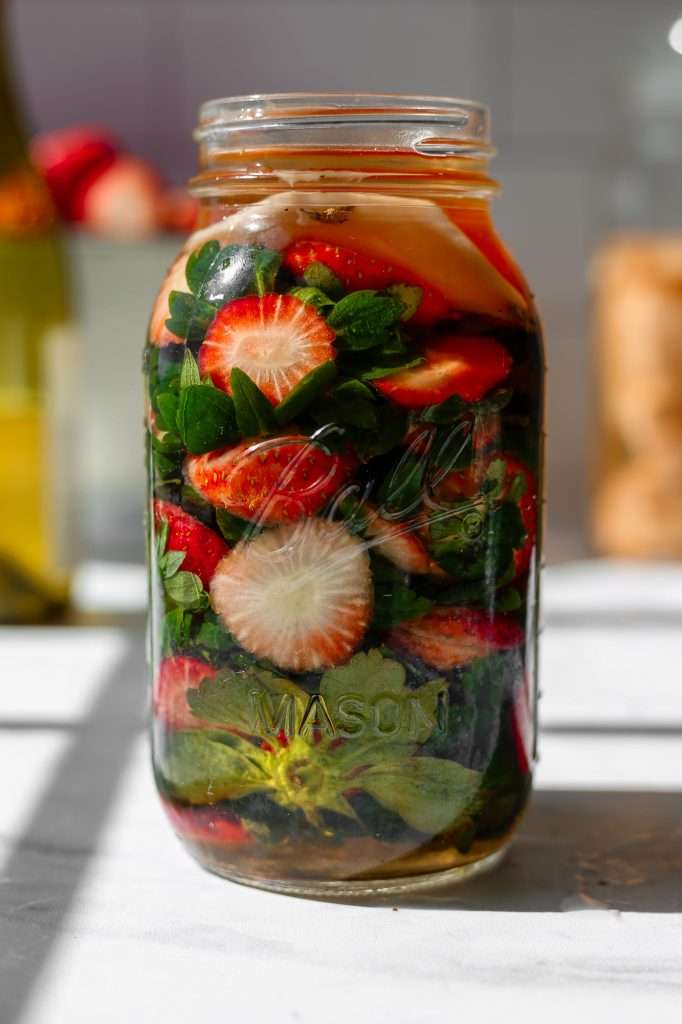
More Vinegar Recipes
- Roasted Pumpkin Vinegar From Scratch
- Homemade Tomato Vinegar Made With Heirloom Cherry Tomatoes
- How to Make Kombucha Vinegar

White Wine Strawberry Vinegar Made with Strawberry Tops
Savor the waste-free magical flavors of white wine strawberry vinegar! 🍓✨ This Strawberry Vinegar recipe transforms leftover strawberry tops and white wine into a delightfully sour vinegar perfect for dressings & marinades.
- Prep: 10 minutes
- Total Time: 1008 hours 10 minutes
Ingredients
- 3 cups strawberry tops
- 16 fl ounces white wine
- 1/4 tsp hydrogen peroxide
- 8 fl ounces water
- 3 tablespoons raw apple cider vinegar with the mother
- 32 ounce glass jar
- cloth covering
- rubber band
Instructions
- Removing the sulfites from white wine before you begin: you cannot skip this step (unless you use verified sulfite-free wine). It will not turn to vinegar if you do not de-sulfite the wine. Pour the 16 ounces of white wine into the glass jar. Add the hydrogen peroxide and stir. Let it sit for five minutes before you continue.
- Add the water to the jar of wine and stir to combine.
- Add in the strawberry tops and stir (or place a lid on and shake).
- Add in a vinegar mother (or liquid vinegar with the mother).
- Place a cloth lid on the jar and secure it with a rubber band.
- Stir the mixture once or twice a day and allow to ferment at room temperature for about three weeks.*see notes
- After three weeks of fermentation, strain out all the strawberry pieces, replace the cloth lid, and allow the mixture to ferment for a few more weeks until a new mother forms on the surface. (it looks like a kombucha SCOBY but is very light in color. You can keep this to start your next batch of vinegar)
- After fermentation, bottle the vinegar and seal it with a solid lid. Store at room temperature in your pantry. It should last as long as store-bought vinegar at room temperature.
Notes
- I use a well established and sturdy vinegar mother scoby when I make this. So, I don’t stir it. The mother SCOBY keeps everything submerged and prevents any unwanted microbial growth on the surface.





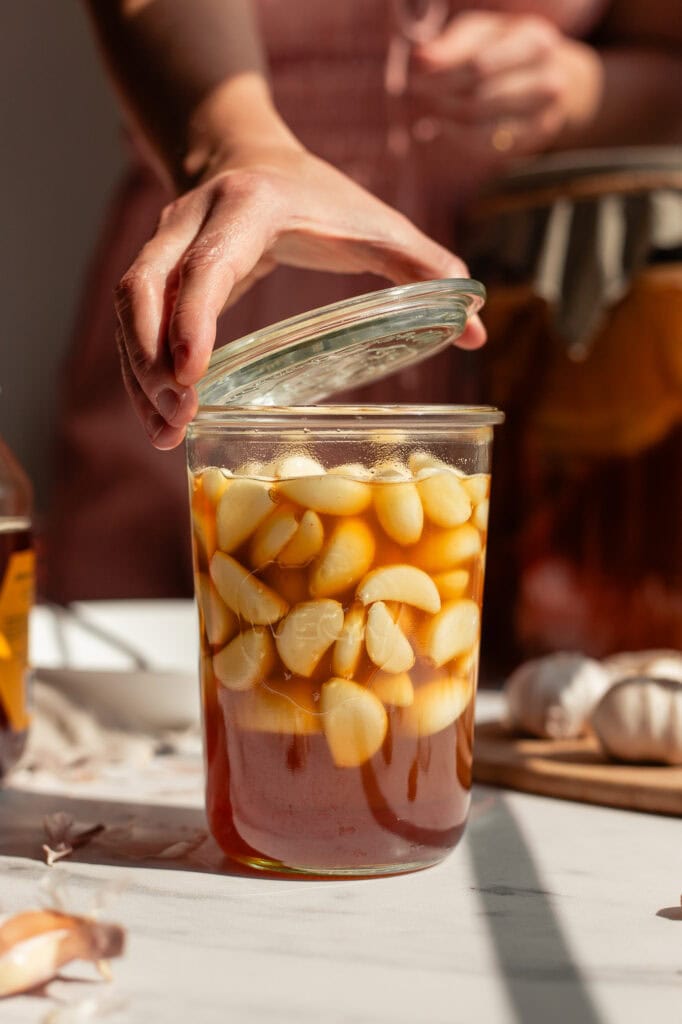














What would I do if I wanted to make strawberry vinegar with just water and no wine?
use my fruit vinegar recipe! How to Make Vinegar from Scratch
Hello, I have made many recipes with success but I started this about 5 days ago and this morning I noticed a white film across the top of one of my jars. Is this mold or normal growth? I have a picture if needed! Thanks!
it could be a pellicile (scoby/mother) forming!
Thanks so much!
Just wondering if I’ve done things properly. The mixture still smells a lot like strawberries and doesn’t have a particularly strong tangy scent. If I continue to let it sit, do you think it’ll continue to turn into vinegar? I did tests the ph-was around 3-3.5!
if you followed the recipe and all the steps then you did it properly. Once you strain it you can let it sit longer. It should smell like vinegar and strawberries.
Hi there- I’ve made a lot of your vinegar recipes and have this one going now with some local Oregon strawberries! It has been a while since I’ve strained it and it seems a bit carbonated. This is something I’ve encountered with other fermented fruit vinegars I’ve made as well, including one that fizzed up out of the jar after I opened it. Any idea why this is happening and what I can do to amend things?
bubbles are normal, but they should stop after a few weeks. If it’s bubbling it might not be done fermenting.
I’m very impressed with your site. Thankyou.
I followed your instructions and made a fabulous ACV.
In the jar was thick scoby , in fact 2 one thinner than the other. I’m very keen to make other vinegars now. My question is, do I put one of the scobys into the raspberry vinegar I’m making, and when I strain the fruit, do I discard the scoby.
I’d be most grateful if you can clarify this point for me.
Best wishes
Pam